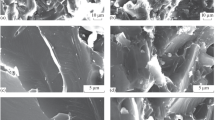Conclusions
-
1.
The effective activation energy of primary recrystallization (46±4 kcal/g-atom) and grain growth (51±4 kcal/g-atom) was determined for all degrees of deformation investigated.
-
2.
The average rate of grain growth at different stages of recrystallization was determined. The increase in the rate of grain growth with increasing degrees of deformation is due to the formation of a larger number of cells with increasing numbers of defects in them.
-
3.
The recrystallization process occurs at a higher rate in extruded beryllium than in rolled beryllium due to the large accumulated energy and the large number of defects.
Similar content being viewed by others
Literature cited
E. D. Martynov et al., "Effect of hydrostatic extrusion on mechanical properties of molybdenum," Fiz. Metal. Metalloved.,23, 6, 1044–1048 (1967).
G. A. Mochalov et al., "Mechanical properties of molybdenum after hydrostatic extrusion," Fiz. Metal. Metalloved.,25, 2, 357–360 (1968).
E. D. Martynov et al., "Electron microscopic study of chromium and molybdenum deformed under high pressures," Dokl. Akad. Nauk SSSR,176, 6, 1276–1277 (1967)
N. N. Buinov et al., "Dislocation arrays in molybdenum deformed by hydrostatic extrusion," Fiz. Metal. Metalloved.,27, 3, 509–515 (1969).
G. A. Mochalov and A. I. Evstyukhin, "Structural features of hardening of polycrystalline molybdenum during hydrostatic extrusion," Fiz. Metal. Metalloved31, 5, 1085 (1971).
I. I. Papirov et al., "Compression of beryllium crystals under high pressures," Fiz. Metal. Metalloved.,28, 3, 524–527 (1969).
V. Damiano et al., TMS AIME,245, 237 (1969).
J. Hanafee and G. London, TMS AIME,245, 2113 (1969).
E. Aladag, H. Pugh, and S. Radcliffe, Acta Met.,17, 1467 (1969).
S. Radcliffe and C. Andrews, Acta Met.,15, 623 (1967).
S. Radcliffe and C. Andrews, Sixth International Conference on Electron Microscopy, Vol. 1 (1966), p. 367.
I. I. Papirov, P. I. Stoev, and I. A. Taranenko, "Electrical resistivity of hydrostatically extruded and annealed beryllium," Fiz. Metal. Metalloved.,34, 5, 1022–1026 (1972).
I. I. Papirov and G. F. Tikhinskii, Physical Metallurgy of Beryllium [in Russian], Atomizdat, Moscow (1968), p. 231.
Hu Sun, Electron Microscopy and Strength of Crystals [Russian translation], Metallurgiya, Moscow (1968), p. 350.
L. A. Kornienko et al., "Recrystallization of rolled beryllium," Fiz. Metal. Metalloved.,29, 1, 138–142 (1970).
Additional information
Translated from Metallovedenie i Termicheskaya Obrabotka Metallov, No. 1, pp. 53–57, January, 1975.
Rights and permissions
About this article
Cite this article
Kornienko, P.A., Nikolaenko, A.A. & Taranenko, I.A. Recrystallization of beryllium subjected to hydrostatic extrusion. Met Sci Heat Treat 17, 56–60 (1975). https://doi.org/10.1007/BF00663091
Issue Date:
DOI: https://doi.org/10.1007/BF00663091



